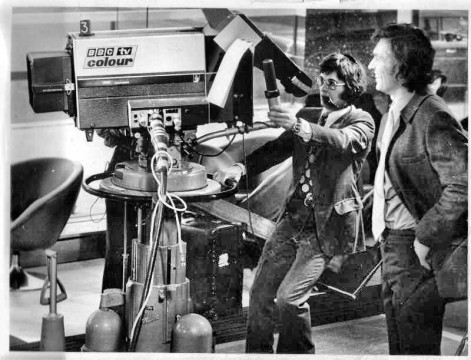Behind the Scenes; A Sort of Innocence from pebblemill on Vimeo.
Video copyright, James French, no reproduction without permission.
James French has provided the following information about this behind the scenes footage which he recorded on location for A Sort of Innocence, known as ‘The Hereford Project’ at the time. The first sequence is by the river in Hereford and the other involves a low-loader being rigged at Chateau Impney in Droitwich Spa:
This was a two camera shoot using CM2 and I (James French) was second camera, Keith Salmon camera supervisor. The cameras were Philips LDK 514s with Angenieux lenses for the techie-types.
The Director was John Gorrie. You hear him but don’t see him in the first sequence. The 1st AD is Peter Rose, who went on to direct several soaps including Crossroads, Eastenders and Coronation Street. Main actor: Kenneth Cranham. Boy: Neil Jeffery, LD: Barry Chatfield, Sparks: Dave Walter, Sound: Tony Wass, Tim Everett.
It was 1986.
The grip’s name was Ron Fleet, and I think the cable basher is rigger, Barry but can’t remember his surname.
EM: Dave Robinson, Spark: Roger Hynes (can’t remember the other guy), Director: John Gorrie seen sitting on the kerb in the early panning shot, Engineer: Peter Eggleston, Vision Mixer: Roger Sutton, Rigger: George Stephenson, Editor: Mike Bloore.
Here is the Radio Times entry from the first episode courtesy of the BBC Genome project:
A six-part serial by ALICK ROWE Episode 1 starring
Kenneth Cranham Cheryl Campbell Michael Byrne
Introducing Neil Jeffery Elizabeth Fellowes seems well suited to life in a small cathedral town. Her husband, Mark, teaches at the cathedral school where her son, Tim, is a chorister. Unknown to the family, boardroom battles are taking place elsewhere. These are to have a dramatic effect on their future lives together.
Music composed by RICHARD HARVEY Script editor JENNY SHERIDAN Designers
MYLES LANG. AMANDA ATKINSON Producer RUTH BOSWELL Director JOHN GORRIE
genome.ch.bbc.co.uk/56046536e8054c6fb2167b2d10c5920f
The following comments were left on the Pebble Mill Facebook page:
Diana Lester: ‘Thanks James, I cannot believe that was over 30 years ago. …lovely to see faces from the past, many who unfortunately are no longer with us ….and we all look so young !!’
Karen Lamb: ‘Hearing Keith’s voice again was so special saying “don’t point it at the sun” such wonderful memories working on crew 5.’
Dawn/Kevin Hudson: ‘Great memories,the grip was Ronnie Fleet, and the fella brushing the path was affectionately known as Gonzo.’
Richard Stevenson: ‘Great clip. Is Tim booming wearing a tie?! Those were the days.’









